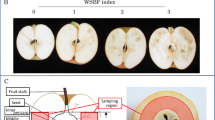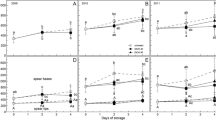Abstract
The increasing occurrence of quality impairing discolourations in market products of white asparagus spears gave rise to a joint research project in Lower Saxony (2009–2012). Here we report on histological studies with asparagus spear tissues collected from different processing treatments after harvest. The aim was to define the symptoms of browning and glassiness, to discriminate them from other discolourations and to characterize the underlying tissue damage at the microscopic level.
Macroscopic symptom characteristics were established to separate browning and glassiness from rusty spots (caused by fungal infections). In microscopy assessments evaluation schemes were developed for brightfield overviews on tissue appearance. Detailed studies of cell viability by vital staining in epifluorescence or confocal laser scanning microscopy (CLSM) revealed irreversible cell alterations in unfixed epidermal and cortical tissues. With fluorochromes SYTOX® Green and FUN® 1 staining methods were adjusted to the compound tissue structure of asparagus spears. Even in asymptomatic tissue samples the epidermal tissue and in particular the guard cells and neighbouring cells of stomata showed a basic damage degree of 30% dead cells. However, this threshold was widely exceeded in tissue samples with browning and glassiness which consisted mostly of irreversibly damaged epidermal and cortical cells. Glassiness was experimentally shown to be primarily caused by mechanical injury or pressure in combination with watering of the spear. This symptom of glassiness converted to browning under increased storage temperature, thus verifying the linkage of both symptoms
Similar content being viewed by others
References
Agizzio AP, Cunha M, da Carvalho AO, Oliveira MA, Ribeiro SFF & Gomes VM, 2006. The antifungal properties of a 2S albumin-homologous protein from passion fruit seeds involve plasma membrane permeabilization and ultrastructural alterations in yeast cells. Plant Science 171, 515–522.
Avis TJ, Rioux D, Simard M, Michaud M & Tweddell RJ, 2009. Ultrastructural alterations in Fusarium sambucinum and Heterobasidion annosum treated with aluminum chloride and sodium metabisulfite. Phytopathology 99, 167–175.
Blok WJ & Bollen GJ, 1995. Fungi on roots and stem bases of asparagus in the Netherlands: species and pathogenicity. Eur J Plant Pathol 101, 15–24.
Bradatsch C, 2014. Analyse der Ursachen von Stangenmängeln, insbesondere von Braunverfärbungen von Spargelstangen, und Entwicklung von Strategien zur Verminderung derselben in der Prozesskette der Spargelproduktion. Dissertation Gottfried Wilhelm Leibniz Universität Hannover. (in German with English abstract).
Bradatsch C, Grunewaldt-Stöcker G & von Alten H, 2011. Mögliche Ursachen von Braunverfärbungen. Spargel & Erdbeer-Profi 2, 26–29.
Chang DCN, 1983. Fine structural changes of asparagus spear during storage. Postharvest Physiology and Storage, Acta Horticulturae 138, 305–312.
European commission, 1999: http://staging.fsai.ie/uploadedFiles/Consol_Reg2377_1999.pdf.
European commission, 2005: COMMISSION REGULATION (EC) No 1050/2005. http://eur-lex.europa.eu/LexUriServ/LexUriServ.do?uri=OJ:L:2005:173:0003:0004:EN:PDF.
Gordon-Lenox G & Gindrat D, 1987. Relationship of root necrosis potential of soil to asparagus (Asparagus officinalis) decline in Switzerland. Biol & Fertil Soils 3, 195–198.
Gossmann M, Büttner C & Bedlan G, 2001. Untersuchungen von Spargel (Asparagus officinalis L.) aus Jung- und Ertragsanlagen in Deutschland und Österreich auf Infektionen mit Fusarium-Arten. Pflanzenschutzberichte 59, 45–54.
Hennion S & Hartmann C, 1990. Respiration and ethylene in harvested asparagus spears during aging at 20°C. Scientia horticulturae 43, 189–195.
Herppich WB & Huyskens-Keil S, 2008. Cell wall biochemistry and biomechanics of harvested white asparagus shoots as affected by temperature. Ann Appl Biol 152, 377–388.
Heyes JA, Bucknell TT & Clark CJ, 2001. Water loss and quality loss during postharvest storage of asparagus and broccoli: a magnetic resonance imaging study. IV International Conference on Postharvest Science, Acta Horticulturae 553/2, 491–493.
Heyes JA & Clark JC, 2003. Magnetic resonance imaging of water movement through asparagus. Functional Plant Biol 30, 1089-1085.
Holm S, 1979. A simple sequentially rejective multiple test procedure. Scand J Stat 6, 65–70.
Hua SST, Brandl M & Eng JG, 2007. Fluorescent microscopic studies in the interactions of Pichia anomala and Aspergillus flavus. Bulletin OILB/SROP 30, 6, 165–169.
Kadau R, 2005. Untersuchungen zu qualitätsbeeinflussenden, nacherntephysiologischen und phytopathologischen Prozessen bei Convenience-Produkten während der Kurzzeitlagerung am Beispiel von Spargel (Asparagus officinalis L.). Dissertation HU Berlin, Landwirtschaftlich-Gärtnerische Fakultät. (in German with English abstract) urn:nbn:de:kobv:11-10047669.
Krasnow M, Matthews M & Shackel K, 2008. Evidence for substantial maintenance of membrane integrity and cell viability in normally developing grape (Vitis vinifera L.) berries throughout development. J Exp Bot 59, 849–859.
Lill RE, 2002. Asparagus: Life after harvest. X International Asparagus Symposium, Acta Horticulturae 589, 349–352.
Lipton WJ, 1990. Postharvest biology of fresh asparagus. Horticultural Reviews 12: 69–155.
Millard PJ, Roth BL, Thi HP, Yue ST & Haugland RP, 1997. Development of the FUN-1 family of fluorescent probes for vacuole labeling and viability testing of yeasts. Appl Environ Microbiol 63, 2897–2905.
Nothnagel T, Krämer R, Schreyer L & Rabenstein F, 2013. Untersuchungen zum Auftreten von Braunverfärbungen bei Spargel (Asparagus officinalis L.) unter besonderer Berücksichtigung des Befalls mit Fusarium spp. und Viren in Spargelanlagen Sachsen-Anhalts. J Kulturpflanzen 65, 50–59.
Pina-Vaz C, Sansonetty F, Rodrigues AG, Costa-de-Oliveira S, Martinez-de-Oliveira J & Fonseca AF, 2001. Susceptibility to fluconazole of Candida clinical isolates dertemined by FUN-1 staining withflow cytometry and epifluorescence microscopy. J Med Microbiol 50, 375–382.
R Development Core Team, 2010. R: A language and environment for statistical computing. R Foundation for Statistical Computing, version 2.11.1, Vienna, Austria.
Roth BL, Poot M, Yue ST & Millard PJ, 1997. Bacterial viability and antibiotic susceptibility testing with SYTOX green nucleic acid stain. Appl Environ Microbiol 63, 2421–2431.
Sun J-Y, Gaudet DA, Lu Z-X, Frick M, Puchalski B & Laroche A, 2008. Characterization and antifungal properties of wheat nonspecific lipid transfer proteins. Molec Plant-Microbe Interact 21, 346–360.
Truernit E & Haseloff J, 2008. A simple way to identify non-viable cells within living plant tissue using confocal microscopy. Plant Methods 4:15 doi:10.1186/1746-4811-4-15.
Van Zandycke SM, Simal O, Gualdoni S & Smart KA, 2003. Determination of yeast viability using fluorophores. J Amer Soc Brewing Chemists 61, 15–22.
Waldron KW & Selvendran RR, 1990. Composition of the cell walls of different asparagus (Asparagus officinalis) tissues. Physiologia Plantarum 80, 568–575.
Zum Eschenhoff H, Kraushaar N & Weber D, 2013. Was tun gegen Verbräunung von Spargelstangen? Ergebnisse eines Forschungsprojektes. 12.07.2013. http://www.lwk-niedersachsen.de/index.cfm/portal/gartenbau/nav/304/article/22533.html.
Author information
Authors and Affiliations
Corresponding author
Rights and permissions
About this article
Cite this article
Rempe-Vespermann, N., Grunewaldt-Stöcker, G. & von Alten, H. Histological characterization of browning and glassiness — quality deficiencies of white asparagus spears (Asparagus officinalis). J Plant Dis Prot 121, 250–259 (2014). https://doi.org/10.1007/BF03356520
Received:
Accepted:
Published:
Issue Date:
DOI: https://doi.org/10.1007/BF03356520




